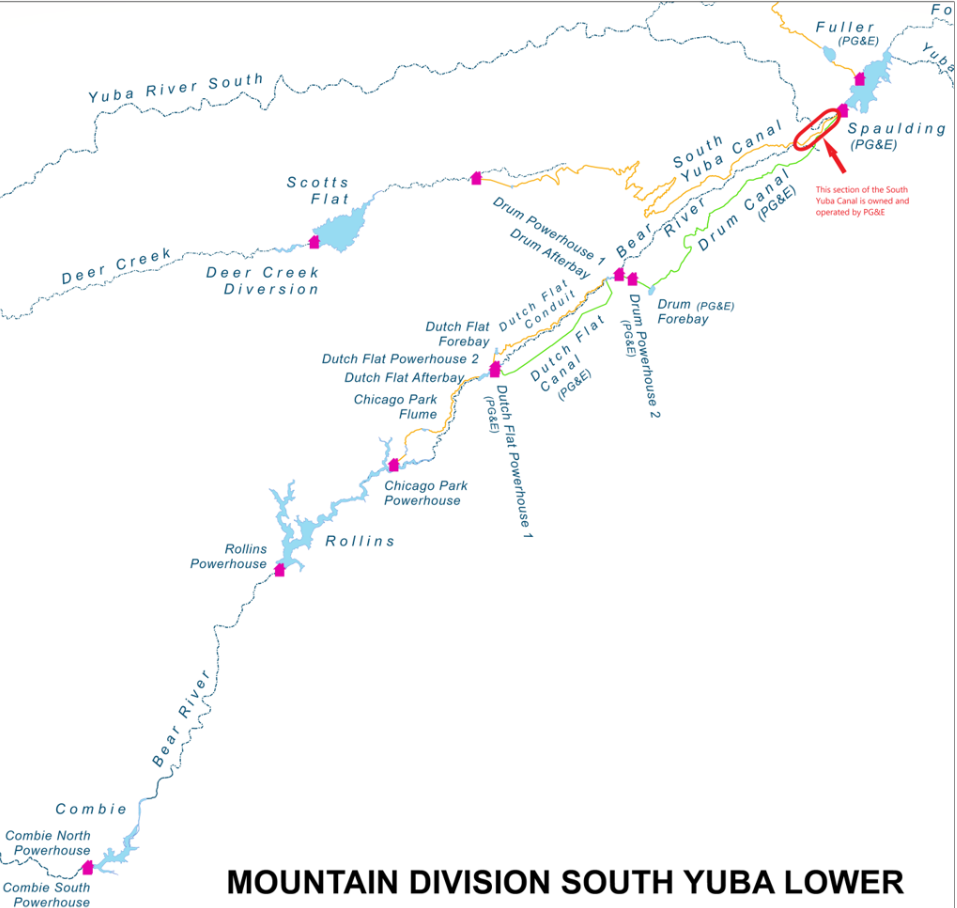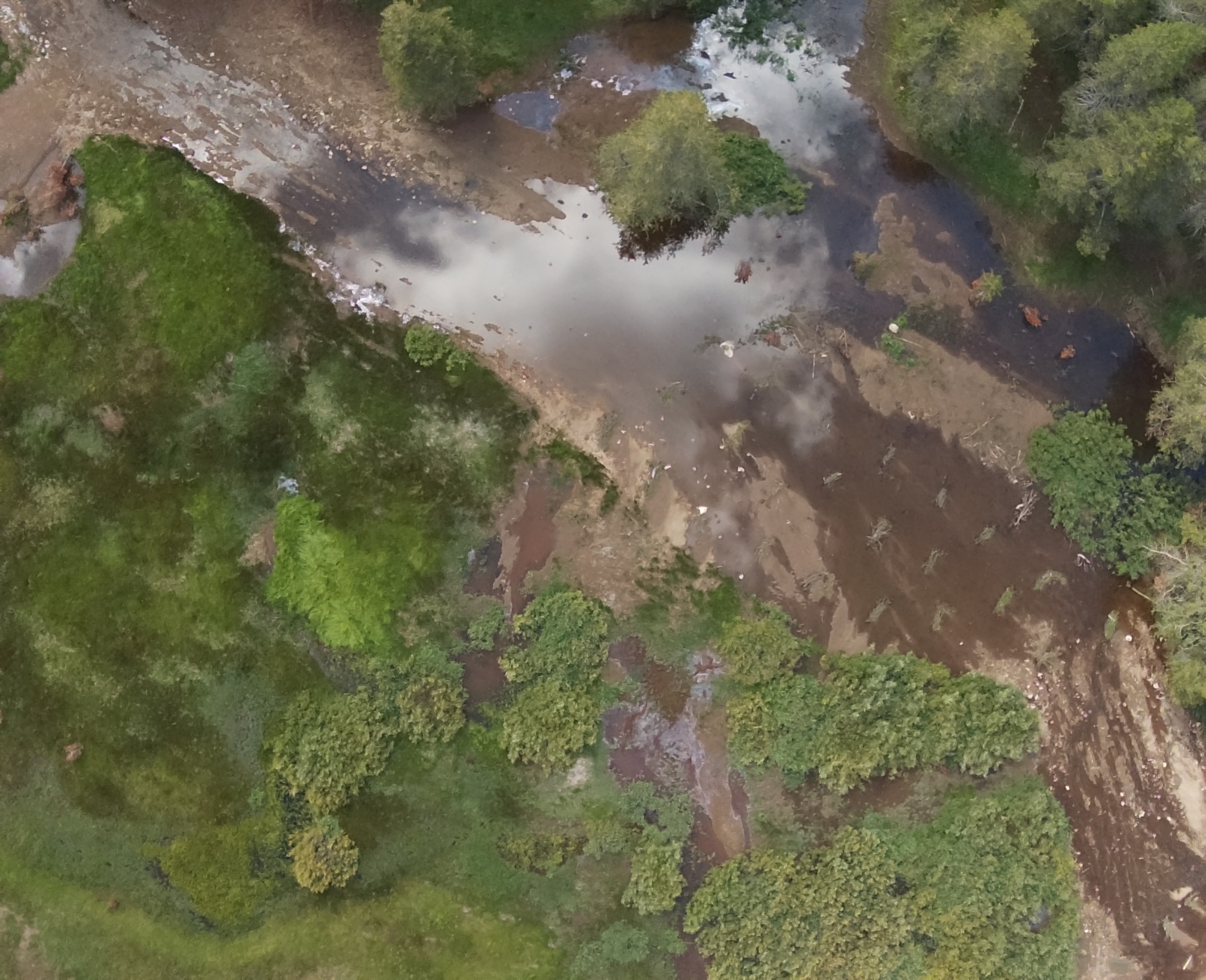PG&E Powerhouse Failure on the Yuba — CPUC to Decide on PG&E’s Proposal to Transfer Hydroelectric Projects
On March 6th and 7th , a significant leak was found at the PG&E Spaulding Powerhouse. About two weeks later, the community learned that there was significant additional damage — columns in the powerhouse had crumbled. Pipes that divert water to the South Yuba and Bear River were also damaged in an earlier storm, leading to a significant cut-off to water flow. These events have raised concerns about the reliability of this aging infrastructure and highlighted the urgent need to address these vulnerabilities.

Ironically, on March 18th, a proposed decision from the California Public Utilities Commission was released that, if approved, would deny PG&E’s application to transfer all of its hydroelectric assets, including the Drum Spaulding Project on the Yuba River, to Pacific Generation (PacGen), a new subsidiary that PG&E would create and hold a 51% interest in. PG&E’s Hydroelectric Project on the South Yuba is just one of many hydroelectric projects PG&E is responsible for throughout the state. SYRCL, and many of our partners are concerned that if this transfer were allowed to happen, the responsibility and accountability for the deferred maintenance of PG&Es infrastructure may be transferred away from PG&E, potentially shielding them from liability.
The Spaulding Reservoir is located on the South Yuba River and is part of the Drum-Spaulding Hydroelectric Project. This was PG&E’s first major hydro project – it captures water from the tributaries of the South Yuba and diverts that water into storage reservoirs, sending the water through the Drum Canal to the Bear River and eventually to western Placer County into the American River watershed. The Spaulding 1 powerhouse was built and placed in commercial operations in 1917 and was rebuilt in May of 1928. The original license, outlining how and what conditions the project would be operated under, was issued on April 30, 1963. While SYRCL participated in multi-year negotiations for new and improved license conditions, PG&E and other licensees continue to operate under the same conditions from this original license.
NID and PG&E: Interlinked and Overlapping Systems
NID owns and operates the Yuba Bear hydroelectric project – this project is interlinked and overlapping with the Drum-Spaulding Hydroelectric Project. NID’s Milton-Bowman Canal transfers water from the Middle Yuba River to the Bowman Reservoir on Canyon Creek. From there water is transferred to the South Yuba River into the Spaulding Reservoir. At this point, water is routed either through the Drum Canal and to the Bear River or to Deer Creek via the South Yuba Canal.
However, now, because PG&E’s powerhouse and the South Yuba pipe are all inoperable, water can’t be moved through the complex plumbing to transfer the water from the Yuba watershed over to Deer Creek and the Bear. The movement of water from the South Yuba to the Deer Creek and Bear River systems plays a large role in NID’s ability to deliver water. The vast majority of the water that NID delivers is raw, untreated water. Only approximately 10% of the water delivered is treated water for human consumption.


PG&E’s application to spinoff hydropower is poised for a decision
Since its proposal in September of 2022, SYRCL, conservation allies, water agencies, and consumer advocates have opposed PG&E’s application to the California Public Utilities Commission (CPUC) to transfer hydropower assets to the newly formed Pacific Generation LLC subsidiary. As members of the California Hydropower Reform Coalition (CHRC), SYRCL has argued that the transfer of hydropower assets introduces a complex new ownership and operational structure that raises significant safety and accountability questions, particularly in the context of dam operations and maintenance of facilities like the Drum Spaulding Hydroelectric Project.
Recently, a CPUC Administrative Law Judge (ALJ) agreed with the CHRC’s concerns, releasing a proposed decision that denies PG&E’s asset spinoff citing risks and potential impacts on the regulatory processes. This proposed denial is a critical decision point and reflects the complexities and potential risks associated with such a transfer.
Now, in the wake of the damage to the Drum Spaulding Powerhouse and the ALJ recommendation, the CPUC is poised to make a final ruling regarding PG&E’s asset transfer. As the CPUC deliberates, the public has a chance to weigh in. With a deadline for a final CPUC decision set for September 2024, there are opportunities for a Commission vote to accept and finalize the ALJ decision at regularly scheduled voting meetings.
SYRCL asks that the public send a comment to the CPUC in advance of their May 9th Meeting.
Your comments are needed before May 9th.
SAMPLE COMMENT IN OPPOSITION TO PG&E’s PROPOSED ASSET TRANSFER
Dear Honorable Members of the California Public Utilities Commission,
Begin by sharing your background and personal experience with rivers and this issue.
I am writing to express my concerns and opposition to PG&E’s current application to transfer its non-nuclear assets, including hydropower projects, to Pacific Generation LLC (PacGen). The CPUC has a responsibility to protect the public interest, particularly when ensuring that PG&E’s transferred facilities operate safely, reliably, and in line with environmental protection principles. I urge the CPUC to stand with Californians who believe this asset transfer is not in the public’s best interest. A decision of this magnitude should not be rubber-stamped without due diligence and thorough consideration of its widespread implications.
Add your concerns (Environmental impacts, Liability and Risk, Dam Safety, etc…)
Thank you for your time and consideration. I look forward to hearing your position on this issue.
Submit your comments electronically:
HOW TO PROVIDE PUBLIC COMMENTS TO THE CPUC
1) Go to the following California Public Utilities Commission Docket link:
2) Enter A2209018 in the box next to the Proceeding Number Search and click the Search button.
3) Click on the blue A2209018 ACTIVE link under the heading Proceeding Number.
4) Click the Public Comments tab at the top of this page
5) On the “A2209018 – Public Comments” page, click the Add Public Comment button (in the middle of the page) and click OK to the Public Records Acts Disclaimer. Then add in your comments as a PG&E Ratepayer, a member of the public, or a stakeholder whom the proposed asset transfer would impact. Fill in your name, city, state, zip code, email & phone number. Verify you are not a robot and hit submit.
Hint: It’s helpful to write your comment first and then copy and paste it into the box provided.
For more information:
- Lake Spaulding powerhouse #1 offline after leak discovered (yubanet.com)
- Details on Spaulding powerhouse damages emerge (yubanet.com)
- March 18, 2024 Calif. law judge recommends rejecting proposed PG&E generation spinoff | S&P Global Market Intelligence (spglobal.com)
- PG&E and PacGen: A risky proposal for the Yuba River, our community, and ratepayers. • SYRCL
- PG&E proposal impacts 500 miles of Rivers. American Whitewater
Did you enjoy this post?
Get new SYRCL articles delivered to your inbox by subscribing to our ENews.





The incidents that have required serious efforts at water conservation demonstrates the vulnerability of our communities to challenges caused by ageing infrastructure, climate change and the natural limits of our ecosystem. Water shortages and wildfires should call our attention to the issue of unbridled growth. Hopefully our community leaders including NID board and staff will make decisions based on promotion of a sustainable community and ecosystem we can all live with and enjoy. Simply planning for more water to spur growth and greed is a dead-end street for our community. Thanks for the opportunity to comment.